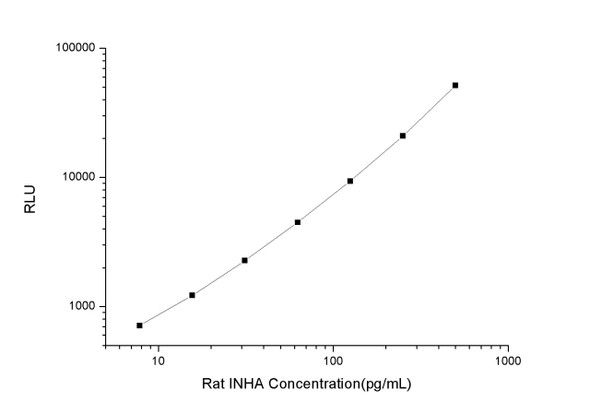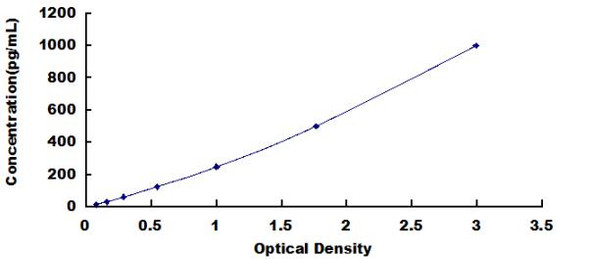Human Cell Biology ELISA Kits 3
Human INHA (Inhibin A) CLIA Kit (HUES00184)
- SKU:
- HUES00184
- Product Type:
- ELISA Kit
- ELISA Type:
- CLIA Kit
- Size:
- 96 Assays
- Sensitivity:
- 4.69pg/mL
- Range:
- 7.81-500pg/mL
- ELISA Type:
- Sandwich
- Synonyms:
- INHA
- Reactivity:
- Human
- Sample Type:
- Serum, plasma and other biological fluids
- Research Area:
- Cell Biology
Description
| Assay type: | Sandwich |
| Format: | 96T |
| Assay time: | 4.5h |
| Reactivity: | Human |
| Detection method: | Chemiluminescence |
| Detection range: | 7.81-500 pg/mL |
| Sensitivity: | 4.69 pg/mL |
| Sample volume: | 100µL |
| Sample type: | Serum, plasma and other biological fluids |
| Repeatability: | CV < 15% |
| Specificity: | This kit recognizes Human INHA in samples. No significant cross-reactivity or interference between Human INHA and analogues was observed. |
This kit uses Sandwich-CLIA as the method. The micro CLIA plate provided in this kit has been pre-coated with an antibody specific to Human INHA. Standards or samples are added to the appropriate micro CLIA plate wells and combined with the specific antibody. Then a biotinylated detection antibody specific for Human INHA and Avidin-Horseradish Peroxidase (HRP) conjugate are added to each micro plate well successively and incubated. Free components are washed away. The substrate solution is added to each well. Only those wells that contain Human INHA, biotinylated detection antibody and Avidin-HRP conjugate will appear fluorescence. The Relative light unit (RLU) value is measured spectrophotometrically by the Chemiluminescence immunoassay analyzer. The RLU value is positively associated with the concentration of Human INHA. The concentration of Human INHA in the samples can be calculated by comparing the RLU of the samples to the standard curve.
| UniProt Protein Function: | INHA: Inhibins and activins inhibit and activate, respectively, the secretion of follitropin by the pituitary gland. Inhibins/activins are involved in regulating a number of diverse functions such as hypothalamic and pituitary hormone secretion, gonadal hormone secretion, germ cell development and maturation, erythroid differentiation, insulin secretion, nerve cell survival, embryonic axial development or bone growth, depending on their subunit composition. Inhibins appear to oppose the functions of activins. Belongs to the TGF-beta family. |
| UniProt Protein Details: | Protein type:Secreted; Secreted, signal peptide Chromosomal Location of Human Ortholog: 2q35 Cellular Component: extracellular region Molecular Function:cytokine activity; growth factor activity; hormone activity; protein binding; receptor binding; transforming growth factor beta receptor binding Biological Process: cell cycle arrest; cell development; cell differentiation; cell surface receptor linked signal transduction; cell-cell signaling; hemoglobin biosynthetic process; negative regulation of B cell differentiation; negative regulation of cell cycle; negative regulation of interferon-gamma biosynthetic process; negative regulation of macrophage differentiation; negative regulation of phosphorylation; positive regulation of follicle-stimulating hormone secretion; regulation of apoptosis; regulation of cell cycle; regulation of cell proliferation; regulation of MAPKKK cascade; response to external stimulus; signal transduction; skeletal development |
| NCBI Summary: | This gene encodes a member of the TGF-beta (transforming growth factor-beta) superfamily of proteins. The encoded preproprotein is proteolytically processed to generate multiple peptide products, including the alpha subunit of the inhibin A and B protein complexes. These complexes negatively regulate follicle stimulating hormone secretion from the pituitary gland. Inhibins have also been implicated in regulating numerous cellular processes including cell proliferation, apoptosis, immune response and hormone secretion. Mutations in this gene may be associated with male infertility and premature ovarian failure in female human patients. [provided by RefSeq, Aug 2016] |
| UniProt Code: | P05111 |
| NCBI GenInfo Identifier: | 124274 |
| NCBI Gene ID: | 3623 |
| NCBI Accession: | P05111. 1 |
| UniProt Secondary Accession: | P05111,A8K8H5, |
| UniProt Related Accession: | P05111 |
| Molecular Weight: | 39,670 Da |
| NCBI Full Name: | Inhibin alpha chain |
| NCBI Synonym Full Names: | inhibin alpha subunit |
| NCBI Official Symbol: | INHA |
| NCBI Protein Information: | inhibin alpha chain |
| UniProt Protein Name: | Inhibin alpha chain |
| Protein Family: | Inhibin |
| UniProt Gene Name: | INHA |
As the RLU values of the standard curve may vary according to the conditions of the actual assay performance (e. g. operator, pipetting technique, washing technique or temperature effects), the operator should establish a standard curve for each test. Typical standard curve and data is provided below for reference only.
| Concentration (pg/mL) | RLU | Average | Corrected |
| 500 | 48944 54130 | 51537 | 51508 |
| 250 | 20847 21149 | 20998 | 20969 |
| 125 | 9890 8902 | 9396 | 9367 |
| 62.5 | 4246 4778 | 4512 | 4483 |
| 31.25 | 2346 2252 | 2299 | 2270 |
| 15.63 | 1268 1232 | 1250 | 1221 |
| 7.81 | 734 746 | 740 | 711 |
| 0 | 29 29 | 29 | -- |
Precision
Intra-assay Precision (Precision within an assay): 3 samples with low, mid range and high level Human INHA were tested 20 times on one plate, respectively.
Inter-assay Precision (Precision between assays): 3 samples with low, mid range and high level Human INHA were tested on 3 different plates, 20 replicates in each plate.
| Intra-assay Precision | Inter-assay Precision | |||||
| Sample | 1 | 2 | 3 | 1 | 2 | 3 |
| n | 20 | 20 | 20 | 20 | 20 | 20 |
| Mean (pg/mL) | 25.48 | 78.58 | 201.67 | 27.26 | 85.32 | 219.57 |
| Standard deviation | 3.20 | 7.61 | 14.26 | 2.90 | 6.79 | 17.13 |
| C V (%) | 12.56 | 9.68 | 7.07 | 10.64 | 7.96 | 7.80 |
Recovery
The recovery of Human INHA spiked at three different levels in samples throughout the range of the assay was evaluated in various matrices.
| Sample Type | Range (%) | Average Recovery (%) |
| Serum (n=5) | 84-97 | 90 |
| EDTA plasma (n=5) | 95-110 | 102 |
| Cell culture media (n=5) | 98-113 | 104 |
Linearity
Samples were spiked with high concentrations of Human INHA and diluted with Reference Standard & Sample Diluent to produce samples with values within the range of the assay.
| Serum (n=5) | EDTA plasma (n=5) | Cell culture media (n=5) | ||
| 1:2 | Range (%) | 94-111 | 89-105 | 98-109 |
| Average (%) | 101 | 96 | 104 | |
| 1:4 | Range (%) | 101-116 | 98-115 | 100-118 |
| Average (%) | 108 | 106 | 109 | |
| 1:8 | Range (%) | 86-98 | 103-118 | 89-105 |
| Average (%) | 91 | 110 | 96 | |
| 1:16 | Range (%) | 92-108 | 83-97 | 100-117 |
| Average (%) | 100 | 90 | 108 |
An unopened kit can be stored at 4°C for 1 month. If the kit is not used within 1 month, store the items separately according to the following conditions once the kit is received.
| Item | Specifications | Storage |
| Micro CLIA Plate(Dismountable) | 8 wells ×12 strips | -20°C, 6 months |
| Reference Standard | 2 vials | |
| Concentrated Biotinylated Detection Ab (100×) | 1 vial, 120 µL | |
| Concentrated HRP Conjugate (100×) | 1 vial, 120 µL | -20°C(shading light), 6 months |
| Reference Standard & Sample Diluent | 1 vial, 20 mL | 4°C, 6 months |
| Biotinylated Detection Ab Diluent | 1 vial, 14 mL | |
| HRP Conjugate Diluent | 1 vial, 14 mL | |
| Concentrated Wash Buffer (25×) | 1 vial, 30 mL | |
| Substrate Reagent A | 1 vial, 5 mL | 4°C (shading light) |
| Substrate Reagent B | 1 vial, 5 mL | 4°C (shading light) |
| Plate Sealer | 5 pieces | |
| Product Description | 1 copy | |
| Certificate of Analysis | 1 copy |
- Set standard, test sample and control (zero) wells on the pre-coated plate and record theirpositions. It is recommended to measure each standard and sample in duplicate. Note: addall solutions to the bottom of the plate wells while avoiding contact with the well walls. Ensuresolutions do not foam when adding to the wells.
- Aliquot 100µl of standard solutions into the standard wells.
- Add 100µl of Sample / Standard dilution buffer into the control (zero) well.
- Add 100µl of properly diluted sample (serum, plasma, tissue homogenates and otherbiological fluids. ) into test sample wells.
- Cover the plate with the sealer provided in the kit and incubate for 90 min at 37°C.
- Aspirate the liquid from each well, do not wash. Immediately add 100µL of BiotinylatedDetection Ab working solution to each well. Cover the plate with a plate seal and gently mix. Incubate for 1 hour at 37°C.
- Aspirate or decant the solution from the plate and add 350µL of wash buffer to each welland incubate for 1-2 minutes at room temperature. Aspirate the solution from each well andclap the plate on absorbent filter paper to dry. Repeat this process 3 times. Note: a microplatewasher can be used in this step and other wash steps.
- Add 100µL of HRP Conjugate working solution to each well. Cover with a plate seal andincubate for 30 min at 37°C.
- Aspirate or decant the solution from each well. Repeat the wash process for five times asconducted in step 7.
- Add 100µL of Substrate mixture solution to each well. Cover with a new plate seal andincubate for no more than 5 min at 37°C. Protect the plate from light.
- Determine the RLU value of each well immediately.






